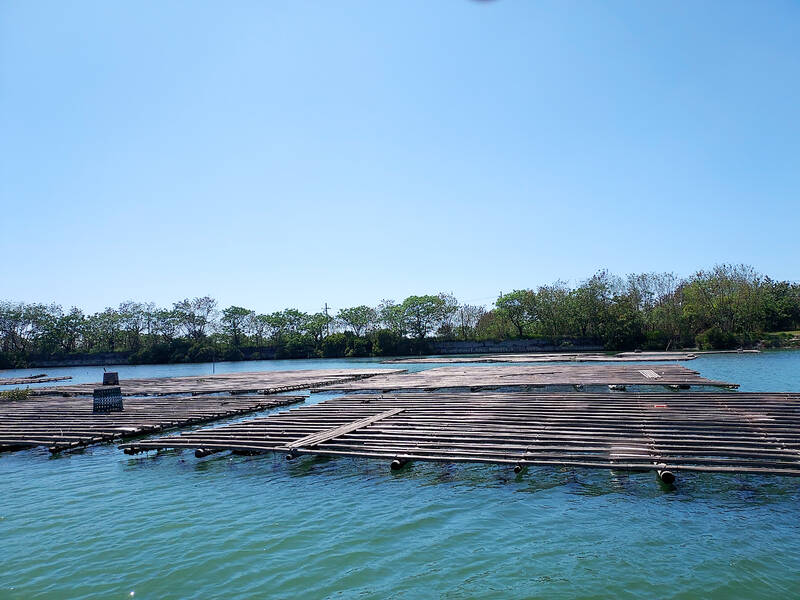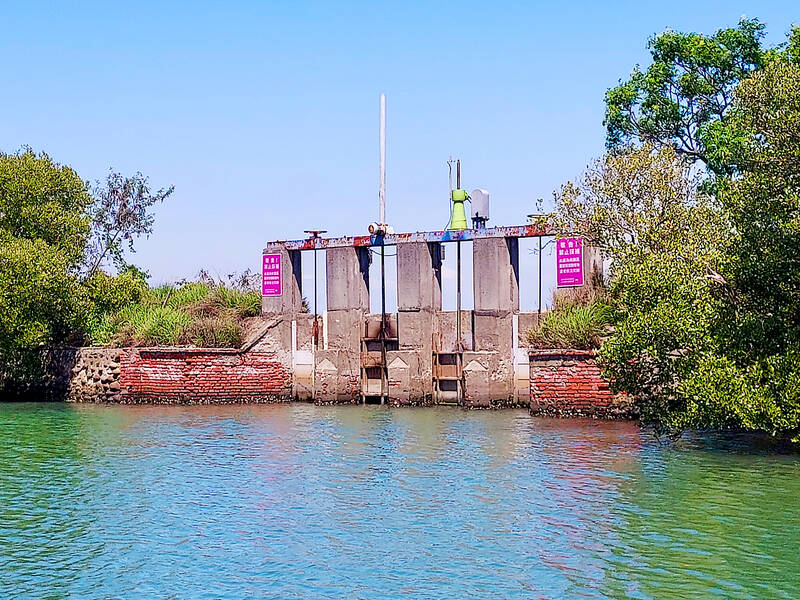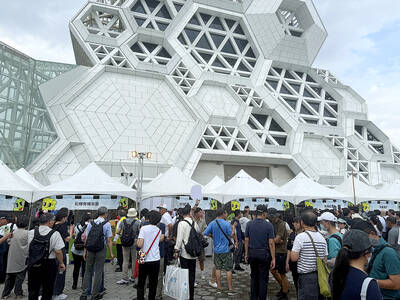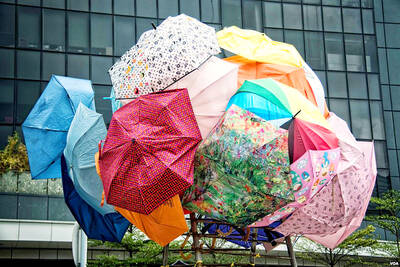At the far western edge of Taiwan lies an ecologically and historically rich expanse of land and sea. Many of Taiwan’s earliest Han settlers landed here in what is today’s Tainan. As their descendants and successive waves of immigrants built up economies based on fishing, agriculture, salt harvesting and aquaculture, battles took place here between European and Asian powers for control of the area, the original lagoon silted in and the people’s livelihoods changed. Today, this area is protected as the Taijiang National Park (台江國家公園). Its mangrove wetland is a haven for birdwatchers, but for the average tourist, the boat rides on offer near the Sihcao Dajhong Temple (四草大眾廟) are often their first experience of the park.
SIHCAO GREEN TUNNEL
Seen from above, the inland portion of Taijiang National Park is actually more water than land. It is a labyrinth of rivers, canals and fish ponds on which sits a spindly web of roads. Along some of these waterways, the natural mangrove forest is still preserved. For those interested in a quick introduction to the habitat in photogenic surroundings, look no further than the Green Tunnel boat ride, a 30-minute excursion along a narrow channel with mangroves on either side creating a cool, green canopy above.

Photo: Tyler Cottenie
Visitors are seated on a low-draft PVC pipe boat — the design of which mimics that of traditional bamboo fishing rafts — along with a driver and a guide, and whisked away into a mangrove microcosm. Fiddler crabs thrive on the muddy shoreline, walking among the mangrove pneumatophores, odd-looking vertical aerial roots that help the trees breathe despite the water-logged soil.
The guides here are sure to point out the different species of birds and mangroves that live in this compact space, and any additional wildlife that may make an appearance, such as the mudskipper, a type of fish that can survive and get around out of water for extended periods of time.
Near the end of the channel, the boat driver swings the craft around slowly, giving people on both sides the chance to see (and photograph) an unobstructed view of the green “tunnel” created by the mangroves and their reflection on the calm waters.

Photo: Tyler Cottenie
At the far end of the route, the boat approaches a brick wall with sluice gates. This was the site of the Likin Tax Bureau (釐金局). During the Qing Dynasty, goods in transit by water were assigned a transit tax here, known as likin. The other man-made point of interest on the Green Tunnel ride is the former site of Fort Zeeburg, originally built by the Dutch as a complement to the much larger Fort Zeelandia. Nothing remains today, but back when it was built, the ocean reached this far inland and this was an important defensive position.
The inland sea that existed then has already completely silted in and it is hard to imagine ships sailing through here just three or four centuries ago, yet it is precisely here that Ming warlord Cheng Cheng-kung (鄭成功, also known as Koxinga) landed one of his contingents before mounting a siege on Fort Zeelandia, permanently ousting the Dutch from southern Taiwan.
Koxinga wasn’t the only one to approach Taiwan from this route. Many early Han settlers arrived on Taiwan here, especially once the Dutch forces offered some measure of protection and stability to colonists. In addition, the coast here is a relatively short hop over from the Penghu islands, thus shortening the dangerous open sea voyage. In fact, the western-most point of Taiwan is also within the Taijiang National Park and is marked by a steel-framed lighthouse on a sandy beach, easily accessible by the public. The old immigration route itself even falls within the park’s boundaries, as the park includes a long rectangular area of the ocean stretching from Penghu’s Dongji Islet all the way to Tainan’s coast.

Photo: Tyler Cottenie
RIDE ON THE RIVER
The other boat ride available to tourists here is a 70-minute excursion through another mangrove waterway and up the much larger Yanshuei River (鹽水溪) near downtown Tainan. The wider waterways don’t provide the green tunnel visual effect, but the wide-open space provides a cool sea breeze and expansive views. It also makes for much better birdwatching opportunities. The black-faced spoonbill winters here and was a motivating factor for creating the national park in the first place. Conservation efforts have increased the global population to just over 6,000 individuals — of which over half winter in Tainan — but the species remains endangered.
Human economic activity is more evident on this boat ride as well. The boat sails directly beside oyster-farming operations in the river, comprised of bamboo racks below which the oysters are hung to grow. Oyster farmers can be seen busy at work, unphased by the tourist boats that ply the river daily.

Photo: Tyler Cottenie
Later, the boat passes by another brick wall with sluice gates, this one dating to the Japanese era. It was installed to control water flow to nearby salt evaporation ponds. This industry has all but dried up nowadays, but demonstration ponds have been set up elsewhere in Taijiang National Park for those eager to learn about this historically important part of Tainan’s economy.
WHITE GREEN BUILDINGS
Finally, a curious complex of buildings can be seen on the shore behind the oyster farms, one that ties together elements of Taijiang’s human and natural history. They are conspicuously white, immediately catching the eye in much the same way the spoonbills do. In fact, the buildings were designed to reflect the environment in which they were built. When viewed from above, the buildings are said to resemble a group of spoonbills and egrets, while the white color itself is also reminiscent of the salt piles that were abundant in the area during the years of salt harvesting.

Photo: Tyler Cottenie
The odd sloping angles of the roof resemble the Central Mountain Range, far away on the horizon. Driftwood and oyster shells are incorporated into the complex’s exterior, further integrating it with the natural environment. Finally, the buildings are partially on stilts above water, reflecting the importance of water to the local economy over the centuries.
These buildings are the park’s headquarters and visitor center and are worth a visit on their own. They are an interesting blend of rather sterile modern architecture with soothing natural elements, while their contrasting colors, irregular shapes and stark lines make them highly photogenic. The buildings are also styled as “green buildings” as they incorporate innovative features that make them more energy-efficient. To learn more about this unique complex, guided tours are available four times a day. The visitor center offers a wealth of information on the ecology of Taijiang, as well as the human history of the area.
Whether your interest lies in birdwatching, geography, history, aquaculture, architecture, photography or just going for a nice boat ride, Taijiang National Park has something for you.

Water management is one of the most powerful forces shaping modern Taiwan’s landscapes and politics. Many of Taiwan’s township and county boundaries are defined by watersheds. The current course of the mighty Jhuoshuei River (濁水溪) was largely established by Japanese embankment building during the 1918-1923 period. Taoyuan is dotted with ponds constructed by settlers from China during the Qing period. Countless local civic actions have been driven by opposition to water projects. Last week something like 2,600mm of rain fell on southern Taiwan in seven days, peaking at over 2,800mm in Duona (多納) in Kaohsiung’s Maolin District (茂林), according to

Aug. 11 to Aug. 17 Those who never heard of architect Hsiu Tse-lan (修澤蘭) must have seen her work — on the reverse of the NT$100 bill is the Yangmingshan Zhongshan Hall (陽明山中山樓). Then-president Chiang Kai-shek (蔣介石) reportedly hand-picked her for the job and gave her just 13 months to complete it in time for the centennial of Republic of China founder Sun Yat-sen’s birth on Nov. 12, 1966. Another landmark project is Garden City (花園新城) in New Taipei City’s Sindian District (新店) — Taiwan’s first mountainside planned community, which Hsiu initiated in 1968. She was involved in every stage, from selecting

The latest edition of the Japan-Taiwan Fruit Festival took place in Kaohsiung on July 26 and 27. During the weekend, the dockside in front of the iconic Music Center was full of food stalls, and a stage welcomed performers. After the French-themed festival earlier in the summer, this is another example of Kaohsiung’s efforts to make the city more international. The event was originally initiated by the Japan-Taiwan Exchange Association in 2022. The goal was “to commemorate [the association’s] 50th anniversary and further strengthen the longstanding friendship between Japan and Taiwan,” says Kaohsiung Director-General of International Affairs Chang Yen-ching (張硯卿). “The first two editions

It was Christmas Eve 2024 and 19-year-old Chloe Cheung was lying in bed at home in Leeds when she found out the Chinese authorities had put a bounty on her head. As she scrolled through Instagram looking at festive songs, a stream of messages from old school friends started coming into her phone. Look at the news, they told her. Media outlets across east Asia were reporting that Cheung, who had just finished her A-levels, had been declared a threat to national security by officials in Hong Kong. There was an offer of HK$1m (NT$3.81 million) to anyone who could assist